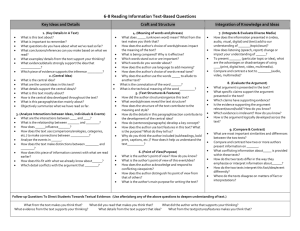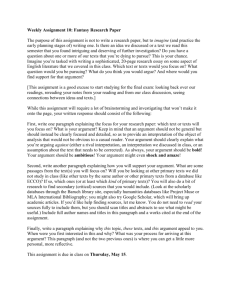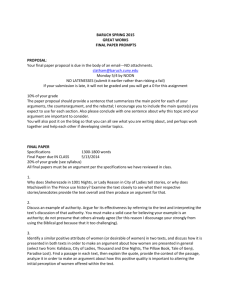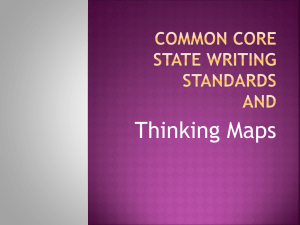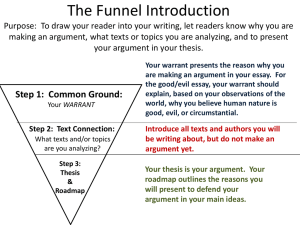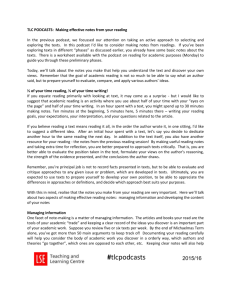integrating text with visual data and multimodal research
advertisement
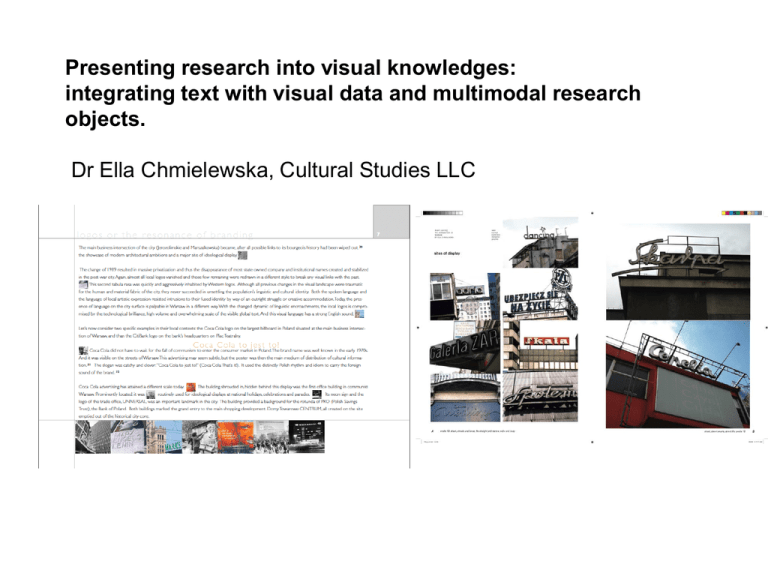
Presenting research into visual knowledges: integrating text with visual data and multimodal research objects. Dr Ella Chmielewska, Cultural Studies LLC It is an accepted assumption that in the humanities we deal with texts. Indeed, we even argue that all objects of our research could be treated as texts to be read and interpreted and we largely follow Wittgenstein’s dictum that if we cannot say it (in text, in a traditionally rendered written argument) we cannot say it at all. Norms of academic publishing impose restrictions on visual data guarding the fixed position of the written word from the contamination by the “graven image”, but since we do privilege texts, this should not be of our concern. What if we work on visual texts, though, and on the relationship between text and image? Or visual text and its context? What if the corpus of our work is in the form of complex visual material and my theoretical propositions give equal status to visual and written arguments? How can we present such visual research? What tools and technical support for working with the visual do we have at my disposal? What are our avenues of presenting research outside of traditional journals that typically limit numbers of "illustrations", or brief conference presentations ruled by their ubiquitous PowerPoint displays? What are the possibilities of "exhibiting" academic work if research may not necessarily qualify as “art” to be shown in galleries? What are the funding possibilities for disseminating visual work in curated shows or web-based displays? Considering the state of development of visual technologies, what innovative publishing outputs could we pursue and what publishing tools could we demand? (assuming that we can make any technological demands if my work is set within the humanities). My work is strongly image-based as it mainly concerns urban visual landscapes, visual knowledges and visual culture. This visual character presents both challenges and opportunities embedded in the multimodal material that constitutes simultaneously the corpus, research tool, and the research output. My visual data includes my own photographic material and design work, documents from various photographic and media archives including aerial photography and maps, drawings and popular print material (from magazines and newspapers), design artifacts and art objects, as well as a variety of documents that record the processes of change and transformation of the urban visual realm. I see a paradoxical quantitative condition with regards to the qualitative research on the visual: In publications (in cultural studies, cultural theory, visual studies, social semiotics, art history, even in architecture) I am typically given a number of images with which I am allowed to embellish my textual exposition. The numbers vary: 4 to 6 is the norm. It is, of course, possible to publish the visual material in professional architectural magazines or submit images as visual essays. These venues do not allow for longer texts, however, and are not partciularly suitable for publishing theoretical reflections. Recently, in a chapter on Public Art in Canada (University of Toronto Press) in my essay on photographing graffiti in Montreal, I could use only six images but I needed eleven which I was allowed in the end but only because I successfully argued that six of them were really one aggregate. Still, I could only use B&W images which significantly compromised my visual argument. In a comparative essay on the semiotic landscape, in another publication, I was given the limit of eight B&W images and a chance to compete for one in colour. I had proposed a singular colour image and had completely rewritten my paper (that originally demanded 24 images) and submitted one composite image of four pictures. Similarly, in an earlier work on visual landscape, I was allowed use only six images, but composed my visual material into triads and thus managed 18. For a chapter in a recent book on City and Art, I was given a luxury of a colour insert and managed over 50 images set in triads, but the editor had no problem with the number which was extraordinary. Still it was an insert… It may sound as if it is all about numbers, but other issues are at stake here. What happens to the argument if I have to build it around a specified number of images? What happens to the content if I can only show it in a prescribed number of expositions? Typically what is not considered is a possibility that my textual argument is inherently linked to the visual material and that changing the number of images would necessitate writing of a different text. That I simply cannot make some points on visuality without involving visual material in the presentation of my argument. (Even de Saussure who seemed to have little use for images, resorted to diagrams for his basic propositions.) In an article in Space and Culture (a journal published by Sage), I was able to use as many in-text images as my argument demanded. The article, “Logos or the Resonance of Branding” was a breakthrough. Arguing for a close reading of prosaic cultural objects and their immediate surroundings, the article drew out the linguistic and graphic nature of the minimal urban texts while indexing the entirety of visual landscape. In examining brand names in specific locales and within their particular symbolic and linguistic contexts the work considered two interrelated questions: What is the logo’s relationship with the specific place of its display? And what is the impact of its linguistic idiom, its graphic and sound image, on the local language? My written argument contains a heavy dose of theory as well as a detailed site investigation and both lines of inquiry are supported by 51 images. A similar visual material was accepted by Space and Culture again in an article on graffiti and place. By then the editors trusted my method: all my images were carefully prepared and sized in a modular form that allowed the editor to easily work with page layout. This also allowed me to develop a model for a working structure of text and a beginning of a system for managing my visual data. I am happy with these articles, but both are compromises. Not only because of the absence of colour but also because their final shape is a result of a page setup and working with the editor on a fixed document rather than a result of a dynamic word and imageprocessing that could be a tool, linking my massive collection of photos, annotating all visual data and thus allowing me to work with both text and image without exploding the Word files. I am interested in the process of contructing arguments that fuse the discursive and representational elements, that give words and images the same epistemologivcal status. While this seems possible in a finished product (a designed page) it is not yet attainable in the process of writing. I have envisioned a word/image processing tool that could provide me with a “footnoting” funtion that could access images from a database and position them on a page like on a light table. My new project on the post-socialist city that I have began last year with Mark Dorrian in Architecture at Edinburgh, proves far more demanding (Tracking the City Project). It is a project on critical pedagogies and new methodologies of urban research. In addition to the material that I would normally work with (own photographic documentation, photographic archives, maps, press material, and archival documents) the project involves massive data sets collected in MArch research projects (urban plans and aerial photography) and the output from exhibitions and seminars that have been part of our work in the last year (variety of media: video recordings, animation, book projects, design objects, creative writing and photography, book objects and narrative objects, models of various scales, results from technical studies, as well as sketchbooks and visual diaries). For this project we need a sophisticated tool that is not merely an image managing software but could be a workbench: allowing to integrate text with visual data and multimodal research into a work environment, a dynamic platform from which critical and theoretical, as well as interpretative and curatorial work could be carried out. I need a tool which could function like my sketchbook, a platform that will facilitate working with a variety of visual material. I need a workbench for the humanities.
